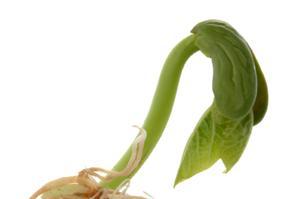| Complexity level: | 4 |
| Project cost ($): | 10 |
| Time required: | 5 days to prepare, 10 days for the science project experiment |
| Material availability: | Easily found |
| Safety concerns: | Basic safety requirements |
Hypothesis
The roots of a germinated green bean will grow towards moisture.
Overview
Hydrotropism
Hydrotropism refers to the way a plant will respond, in terms of direction of growth, towards concentrations of water in soil. It occurs when the root cap of the plant senses where the water is located and starts to grow towards that part of the soil that contains a higher concentration of water. Plants do this to avoid drought stress.
This ability of the plant’s root to seek water in soil is important because plants need water to grow and perform photosynthesis. Plants also need water to transport minerals from the soil to other parts of the plant. Without enough water, plants will wilt and dry. Prolonged deprivation of water will eventually cause the plant to die.
Studying plant growth in response to moisture is quite difficult because such tests are usually done in laboratory conditions and not in the plants natural environment. The study of hydrotropism is sometimes done together with geotropism. Geotropism is the response of the roots and the stem towards gravitational pull. Roots grow towards gravity while the stem grows away from gravity.
Scientific Terms
Materials
The materials required for this science fair project:
- 1 packet of green beans
- 3 gardening pots
- Soil for the 3 pots
- Gardening spade
- Tap water
- 3 porous cups
- A black marker pen
Procedure
1. For this science fair project, the independent variable is the watering method used on the 3 pots – watering from the porous cup or watering directly onto the soil. The dependent variable is the direction the roots grow in the soil. This is determined by removing the plants from the soil after 15 days and inspecting how the roots have grown. The constants (control variables) are the size of the pot, the amount of sunlight, room temperature and the amount of water added daily.
2. Fill the3 gardening pots with equal amounts of soil. The porous cups are planted in the soil with the top of the porous cups left protruding. 10 green beans are planted in each pot. Additional beans can be placed in the pot and removed later in case some of the seeds do not germinate. The 3 pots are labeled “A”, “B” and “C”.
3. The 3 pots are watered daily for the next 5 days and the beans are allowed to germinate. After 5 days, the porous cups in pots “A” and “B” are filled with water. The porous cup in pot “C” is not filled with water. For the next 10 days, the soil in only pots “B” and “C” will be watered daily. The soil in pot A is not watered.
4. After 10 days, the porous cups are removed from the soil. The soil around the green bean plant roots is gently removed and it is observed to see if the roots of the plants have grown straight down or sideways towards the porous cup. The observations are recorded in the table given below.
Results
The results show that the roots in all 3 pots grew straight down. None of the roots in the 3 pots grew towards the porous cup.
| Condition | Observation |
| A : Water in porous cup only | Roots grew straight down |
| B : Water in porous cup and soil | Roots grew straight down |
| C : Water in soil only | Roots grew straight down |
Conclusion
The hypothesis that the roots of the germinated green bean will grow towards moisture if the soil is dry is disproved.
The growth of a plant can be induced by geotropism, phototropism, hydrotropism or chemotropism. Geotropism is how the growth of a plant is affected by gravitational pull. As the stem grows away from the gravity, the roots will grow towards the pull of gravity. Phototropism is how a plant will bend and grow towards a light source. Hydrotropism and chemotropism is the study of how roots will bend towards moisture or a chemical source in the soil.
Also consider
Try to repeat this science fair project by using different types of seeds like corn seeds or soy beans. Would your results be different?
The experiment can be conducted over a longer period of time to observe if the direction of root growth will change as the soil becomes drier.
References
Hydrotropism - http://www.plant-and-flower-guide.com/hydrotropism.html
Induced or paratonic movements - http://www.tutorvista.com/content/biology/biology-iv/plant-growth-movements/paratonic-movements.php
Hydrotropism - http://en.wikipedia.org/wiki/Hydrotropism

